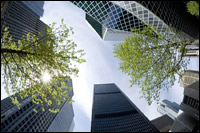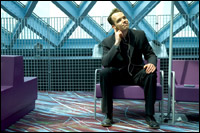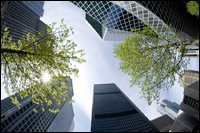“I didn’t like the ‘LEED is broken’ part, but I did like the ‘Let’s fix it’ part,” said U.S. Green Building Council President and CEO Rick Fedrizzi, referring to a critique of his organization’s building-certification program that has been much discussed in green-building circles.

Green building is growing up.
Published this spring by somewhat sympathetic sustainable-business advocates Auden Schendler of the Aspen Skiing Company and Randy Udall of the Community Office for Resource Efficiency in Aspen, Colo., the not-quite-broadside comes as the five-year-old LEED (Leadership in Energy and Environmental Design) program is becoming the default green-building standard in the U.S. and establishing beachheads internationally.
A small but high-profile list of building projects certified under LEED has attracted abundant media attention and generated significant buzz within the building community and beyond. LEED is also rapidly picking up endorsements from businesses, state and local governments, and federal agencies, and accrediting a fast-growing number of building-industry professionals — more than 20,000 at last count.
But, echoing a growing chorus in the green-building community, Schendler and Udall contend that LEED is in crisis. They fault the program’s cost, complexity, bureaucratic requirements, and what they characterize as a frequent disconnect between its emphasis on point allocation and actual environmental benefit.
LEED, We Have a Problem
The core 69-point LEED rating system addresses energy and water use, indoor air quality, materials, siting, and innovation and design. Buildings can earn basic certification or a silver, gold, or platinum designation depending on how many of the possible credits they rack up.
LEED-certified buildings are still about as rare as major wind farms in the U.S. So far, fewer than 300 projects have been certified, and about 2,200 have been registered, according to USGBC officials. Registration involves a fairly simple project description and a summary of the LEED credits the developer expects to earn, but actual certification requires thorough documentation, review, and commissioning, a process that can take many months and, some green-building practitioners argue, considerably drive up costs. LEED-registered projects accounted for just under half a percent of buildings constructed in the U.S. in 2000, and a little over 3.5 percent in 2003, according to USGBC officials. Those low percentages show how far LEED is from revolutionizing the building industry, critics say.
Many developers point to the expense of certification, rather than of green building itself, as a disincentive. The USGBC’s fees for registration range from $750 to $3,750, and certification runs from $1,500 to $7,500, depending on the size of the building. But the big costs come in the form of energy modeling, commissioning, and other requirements of certification; these can run into the tens of thousands of dollars, according to architects and developers.
“There is a significant added cost to certification,” Schendler said. He and Udall, who’ve each worked on multiple LEED projects, write that this can set up a zero-sum budgeting game, in which developers may forgo certification in favor of additional eco-friendly features. “In some cases it’s a question of photovoltaics or LEED,” he said.
Some critics also argue that basic certification is too low a hurdle to merit the green stamp of approval. They say developers can rack up the minimum number of needed points without going much beyond the requirements of local building codes and the efficiency standards of the American Society of Heating, Refrigerating, and Air-Conditioning Engineers.

Pondering ways to make LEED better,
at the silver-certified Seattle Library.
Others note that LEED doesn’t guarantee energy efficiency, as certification can be gained without earning many or even any LEED points in the area. Some green-building advocates would like to see mandatory points for energy efficiency. A point system that weights a renewable-energy system about equal with a bike-storage room needs some refining, they argue.
Seth Kaplan, director of the Conservation Law Foundation’s Clean Energy & Climate Change Program, raises the concern that LEED doesn’t adequately address the siting of a building, which has impact on energy use, traffic, and pollution. “A building with a large parking lot that is full — on a fundamental level, it’s oxymoronic to call it a green building,” he said. A conventional building located in an already developed urban area is arguably more sustainable than a high-performance building in a previously undeveloped area, he noted. The CLF’s LEED-certified headquarters is located in the heart of Boston.
Some industry groups also dismiss the LEED system as burdensome and arbitrary. The National Association of Home Builders, which earlier this year rolled out its own green building guidelines, and the North American Coalition on Green Building, which represents manufacturing and trade associations, have worked to counter the influence of LEED, claiming that it lacks scientific rigor and smacks of undue regulation.
Still, interested parties from across the spectrum recognize that LEED is the dominant green-building standard, so it can’t be ignored. “It got to the point where if a project wasn’t LEED, no one knew it was green,” Schendler said. “It went from a kid brother upstart to an 800-pound gorilla.”
Shot Stuff
“We understand that as the definitive market leader we are the ones who are going to take those shots,” said Fedrizzi, who sounded a diplomatic tone in discussing the tensions around LEED.
The USGBC’s defenders are quick to note that LEED is a work in progress. “We’re in our adolescent stage,” said David Gottfried, founder of the USGBC, the World Green Building Council, and WorldBuild Technologies Inc., a San Francisco consulting firm. “It’s a maturation process.”
The 501(c)(3) nonprofit’s big tent holds nearly 6,000 member organizations — a diverse and sometimes fractious array of interests working through a consensus-based decision-making process. A self-described change agent pushing a voluntary program, the USGBC has been accused of trying to placate everyone, leaving too much flexibility in the system and opening it to manipulation. “We’ve always tried to be consensus-based and open,” said Gottfried. “But, if you take that to the ultimate limit, you can get to a point where you can’t function.”
Industry players, some of them less than obviously green, lobby within the USGBC to influence the direction of LEED. They also campaign outside the organization to advance rival schemes like the NAHB’s green guidelines and the Green Globes green-building guide and self-assessment program, initially established in Canada and the U.K. Both programs are touted as cheaper and more flexible than LEED. Critics argue they don’t hold builders to high enough standards.
In August, the USGBC voted to allow industry trade associations to participate as full members, a decision that disappointed activists like Bill Walsh, national coordinator of the nonprofit Healthy Building Network, a USGBC member. He fears this could tilt the council’s agenda toward business interests. “Since every member of every trade association can also be a member of the USGBC, and often is, this gives some interests in the council two bites at every apple,” he said.
Fedrizzi argues that the USGBC should be able to withstand the extra industry presence. “People have said it will force the organization to be a lowest-common-denominator organization. [But] if a group came in and decided to strong-arm the agenda in one direction or other, I have no worries that the members would protect the organization,” he said.
Spread and Circus
Even as debate roils about LEED’s effectiveness and user-friendliness, the system is spreading rapidly. Federal departments and agencies and state and local governments are adopting LEED as a guideline or requirement for their own projects, and tax breaks and other LEED incentives are cropping up around the U.S. In many ways, LEED’s success is raising the stakes and intensifying arguments over the program’s flaws.
“We use it as a measure of our accomplishment toward our sustainability goals,” said Don Horn, director of the sustainable-design program at the General Services Agency, the federal government’s largest property owner and leasing agent. The agency pegs LEED silver as a goal for its projects, and requires certification as a minimum. “We’ve chosen to use LEED rather than coming up with our own,” he said.
Other federal agencies, more than a dozen state governments, and almost 50 municipalities cite similar “why reinvent the wheel” reasoning for their embrace of the standard. That embrace includes requiring LEED for public projects and encouraging private developers to certify their buildings.
“There are flaws. It might not apply as well to residential [projects] and location may not be emphasized enough,” said John Rahaim, planning director for Seattle, which requires LEED silver certification for new city-owned projects of more than 5,000 square feet. “But it’s largely proven.”
Seattle’s LEED experience hasn’t been an unqualified success. Two major projects, a new city hall and a court building, have undergone rough break-in periods, necessitating some costly fixes to HVAC, green-roof, sun-shading, and other systems. Some of the problems involved building features that earned LEED credits, although it’s unclear whether the problems indicate flaws in the rating system. “The issue of how we might better vet performance for the city’s buildings has cropped up,” said Rahaim. He suggests that monitoring be built into the system, to track how buildings hold up after they’re completed.
But Seattle hasn’t dropped its commitment, and in fact is now looking at adding LEED to its building code. City leaders have proposed that new privately owned buildings above a certain height or square footage be required to earn LEED certification as part of zoning rules, according to Rahaim.
Such proposals make some USGBC officials nervous. The organization gets a substantial boost from government endorsements, but it designed LEED as a voluntary program and doesn’t want to play the potentially awkward role of regulatory enforcer. “We’re not in any way promoting required acceptance of LEED,” said Fedrizzi. “If somebody said, ‘No building public or private will be built in the city unless it’s LEED rated,’ I probably would feel that that was not the right strategy. When you talk about government as an owner, they should have the ability to choose better performance. That’s a voluntary action. Applying that to private projects is a different story.”
The USGBC would rather help nudge building codes in a more sustainable direction, according to Fedrizzi. Thus, the group’s “greening the codes” initiative, an effort to infuse codes with LEED-like requirements. “The building-code system needs to be upgraded,” he said. “If it’s not formally LEED but very green, I think it’d be wonderful.”

It’s time to take LEED to the next
level.
You’ve Got to Admit It’s Getting Better
Looking to maintain its momentum despite the friction in its ranks, the USGBC is working to address member concerns and refine LEED, while broadening it to cover more types of building projects.
The council is drafting and soliciting comment on a mushrooming assortment of new LEED specifications that will expand the system into homebuilding, retail construction, and neighborhood planning, beyond its current purview of primarily commercial and institutional buildings.
It’s also collaborating with veterans of the LEED process to streamline its system for reviewing projects submitted for certification — an effort that was well under way before Schendler and Udall voiced their criticisms. Having already reduced the paperwork load with the last several LEED updates and pushed some of the red tape to the web, the organization will present more revisions at November’s Greenbuild conference in Atlanta. To expedite the certification of registered projects — currently there’s about a three-year lag — the USGBC is looking at phased reviews, a revised auditing scheme, and volume certification for builders, such as retailers, with multiple sites, Fedrizzi said.
Still, he admits, things are likely to slow down before they speed up, given the current backlog and the time required to revamp the process.
Beyond certification, the USGBC is considering ways to ensure that LEED-certified buildings perform well six months, a year, and more after they’re completed, though details like penalties for noncompliance have yet to be worked out.
The council will also be spending time over the coming months trying to resolve controversies over polyvinyl chloride (PVC) plastics and wood-certification systems. Some green-building advocates argue that LEED should encourage the replacement of PVC with more environmentally benign materials. The USGBC’s Technical and Scientific Advisory Committee is expected to release a final report on vinyl later this fall.
And there’s disagreement over whether LEED should give credit for the use of wood certified under the industry-backed Sustainable Forestry Initiative in addition to stocks certified by the Forest Stewardship Council, which is considered to be more rigorous. In September, the USGBC hosted a “wood summit” to begin discussions on the topic.
Both issues will likely be viewed as bellwethers of the group’s approach to reconciling public health, environmental, and business interests, further revealing the hue and saturation of the USGBC’s green.
Whether the council’s efforts to adapt to the market while maintaining and even boosting standards will bring about the transformation sought by critics like Schendler and Udall remains to be seen. The concern for many longtime practitioners of green building is that the skirmishing over acronyms and checklists will distract from the larger battle to make the built environment more sustainable.


